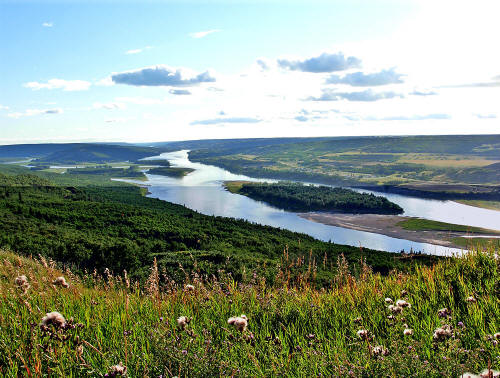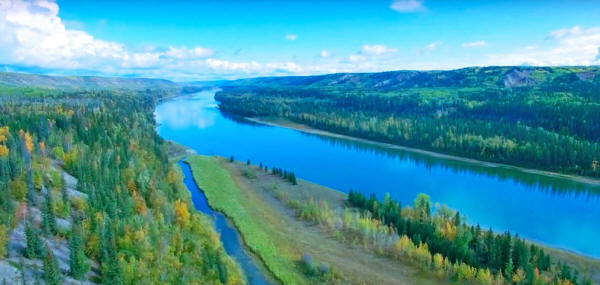|

by Jennifer O'Keeffe
August 09, 2016
from
GlobalResearch Website
|
Jennifer O'Keeffe,
Former COPE Council Candidate 2014, Vancouver B.C. |

Site C Dam is a
proposed 60-metre high, 1,050m length dam on the
Peace River on Treaty 8 territory in
northeastern British Columbia (see image below),
a project that if built, would create an 83km
reservoir submerging 78 First Nations heritage
sites in violation of the Constitution Act, but
how does it connect to continental water
diversion?
To date, much has been said in the media regarding the issue of Site
C Dam, but very little has touched on the matter of NAFTA and water.

Peace River BC
The spin behind the necessity of the project has largely
concentrated on exaggerated claims of the energy needs of Vancouver,
to the BC Liberals' power requirements for the LNG and Fracking
industry, to providing below-market value energy to Alberta in
exchange for agreeing to their pipelines.
Recently, the Justin Trudeau Government
approved two additional permits for Site C Dam despite
recommendations against the project by the Royal Society of Canada
and 250 of Canada's top scientists on the basis that Site C Dam is
an ecological catastrophe and gross violation of rights under the
United Nations Declaration of Indigenous Rights and violates our own
Constitution.
Little, however, has been noted by the media about the
NAWAPA (North America Water Power
Alliance) connection to Site C Dam, and that is something all
Canadians should be seriously concerned about.
NAWAPA is a continental water diversion plan drafted by the US Army
Corps of Engineers during the 1950s -1960s.
Essentially the plan involved diverting
(stealing) water from Canada via the Rocky Mountain Trench to
Southern California. The rivers of Canada in British Columbia and
the Yukon were an integral part of this plan.
In 1964 Parsons Company published a paper called NAWAPA: "North
American Water and Power Alliance," by Roland P. Kelly,
Technical Program manager of "The Ralph M. Parsons Company".
Essentially the paper estimates that
NAWAPA could provide water supply to the continent (i.e.) The United
States for 100 years.
In the proposal, the project would
divert approximately 69,000,000 acre-ft to the United States
Annually.
In Water and Free Trade: The Mulroney
Government's Agenda for Canada's Most Precious Resource, agrologist
Wendy Holm discusses the core aspects:
"The NAWAPA plan proposed by Ralph
Parsons Co. of Los Angeles envisaged building a large number of
the worlds biggest dams to trap the Yukon, Peace and Liard
Rivers into a reservoir that would flood one-tenth of British
Columbia to create a canal from Alaska to Washington State that
would supply water through existing canals and pipelines to most
areas of the continent."
Roland P. Kelly argues:
"Since the water resources of the
continent were placed by nature without regard to political
boundaries, it seems logical…to figure out a distribution system
maximizing these resources without regard to these boundaries".
Obviously, the implications of this
project would have devastating environmental and human impacts, in
addition the destruction of eco-systems and diversion of water would
serve as an accelerant to climate change.
With regard to the Site C Dam, it is worth noting that the proposed
dam site falls directly on the lines drawn in the original NAWAPA
plans.
Site C and the Columbia River Project
are integral to the implementation of NAWAPA, thus calling into
question the nature of the project in relationship to continental
water diversion plans.
It is of the upmost importance to note that, once impounded behind
the dam, the Peace River is subject to NAFTA as a water commodity,
thus putting the people of Canada at risk of loosing water rights if
privatization of BC Hydro occurs.
One might reasonably question BC Hydro's
managed fiscal state of '$18.1 billion in approximate debt' as being
a primer for manufactured
privatization to occur.
The only potentially saving factor in
the political maneuvering behind Site C and Continental Water
Sharing is the fact that the Province of British Columbia is located
on un-ceded territory.
The Governments' title to water is,
therefore, invalid and any quiet agreements made by our politicians
with regard to NAWAPA would not be recognized under International
Law despite corporate interests involved.
The law must be the personal concern of every citizen, to uphold for
our neighbors as well as for ourselves.
-
What does it say if the
Government of Canada is found in violation of section 35(1)
of the Constitution Act, the UN Declaration on the Rights of
Indigenous People and recently the violation of the Wildlife
Act?
-
It is time for people to start
asking questions, who is benefitting from this project and
what is going on behind the scenes?
|



